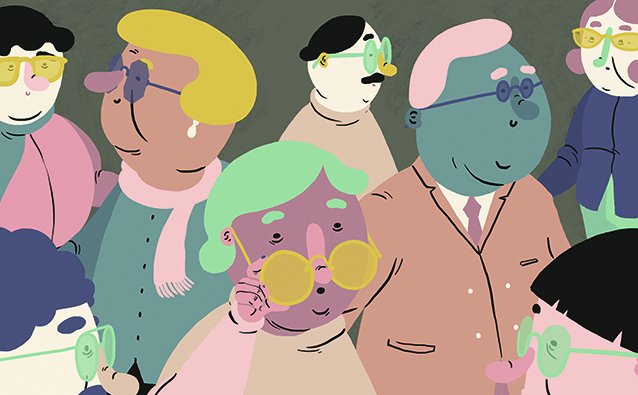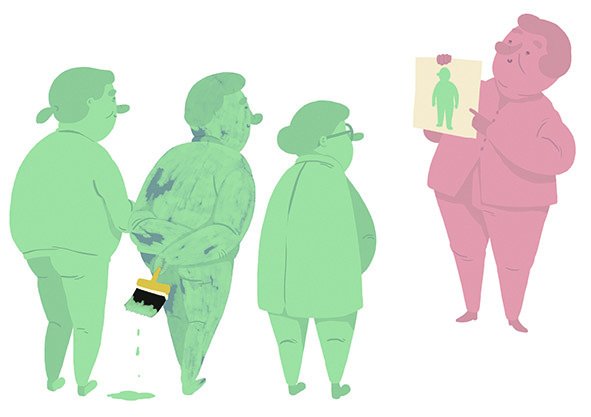Curious about personality
Your personality affects your perception of reality. It also affects your impression of your boss. There is research to support this, but there is also plenty of nonsense in the world of personality tests. The question is: Who are you, really?

Text: Annika Lund (in translation from Swedish). First published in Medicinsk Vetenskap 3/2019.
THE INTEREST IN DESCRIBING people’s character is ancient. More than 2,000 years ago, the scientists of the time divided us into twelve signs of the zodiac, like Cancer and Scorpio, based on the movement of celestial bodies. The results were considered indicative for medical treatments. A few hundred years later, the Greek physician Hippocrates developed humorism, where your personality as well as illnesses were attributed to the balance of your bodily fluids.
To this day, we still use systems to describe our personalities and draw conclusions, for example regarding our health or how we will act in our places of work. However, many of the tests administered in working life are pure nonsense, according to Bo Melin, Professor of Work Psychology at the Department of Clinical Neuroscience at Karolinska Institutet. He places the book Surrounded by Idiots, which divides people into four colour groups, in this category. The theoretical model, called DISA or DISC, has been used by both companies and government agencies in recruitments. Bo Melin finds it highly provocative.

“The naivety of these tests is upsetting to me. Aside from the scientific basis being nonexistent, the result can impact how people look at themselves and each other. If someone is considered ‘a blue person’, there is an obvious risk that this person will always be seen through that lens, where only ‘the blue’ shines through and none of the other aspects,” he says.
The personality test most systematically studied in recruitment is based on the five-factor model of personality, which describes how much or how little you have of the traits Openness to Experience, Conscientiousness, Extraversion, Agreeableness, and Neuroticism. This model was created in the 1950s when a great number of people were describing themselves using different adjectives. An analysis was then carried out of how these adjectives overlapped, and what was left were these five general traits, which are often casually referred to as the Big Five.
The five-factor model
Bo Melin is also sceptical of the five-factor model, at least in the context of recruitment, where the aim is to understand how well someone will succeed in the position they have applied for.
“The five-factor model has a certain explanatory value when it comes to describing the average success of a large group of individuals with certain traits. But the test is not sufficiently sensitive to say something at the individual level, and it cannot be used to distinguish the most suitable individual from a group of some ten similar applicants for a position. At best, the model may fulfil a function as a basis for a constructive interview afterwards. I am surprised that these tests are not more harshly criticised,” says Bo Melin.

However, they have received some criticism. It is for example possible to learn which answers will lead to the desired profile, so the answers can be faked. Furthermore, the five-factor model only describes certain dimensions of a person. It does not give any indication of the extent to which a person has a sense of humour, humility or moral courage, traits which also describe how someone “is”. Nor does the model say anything about cognitive ability, which Bo Melin thinks is a great flaw.
“If you want to narrow it down to a success factor in both working and regular life, then cognitive ability, measured by an aptitude test, is an incredibly important one. It has a high enough explanatory value, which is adequate for use at the individual level as well in the context of complex and cognitively challenging jobs. However, it can be stigmatising to discuss mental ability, as this is largely genetic,” he says.
The concept of “grit”
Bo Melin believes that this is the reason why the concept of “grit”, which can also be measured using a test, has gained ground in recent years. The term describes the ability to always come back and try again, even when faced with tough resistance. It is also a success factor in working life, even if the evidence behind this claim is weaker than for intelligence.
“People are very interested in grit. There are some indications that you can train to improve your grit, which you cannot do in the same way with cognitive ability. This makes the area interesting for the professional sector in general and for consultants, who can then be hired to improve employee grit,” says Bo Melin.
The term personality has no clear definition. Generally speaking, it is used to describe the dimensions of a person’s emotional, cognitive and behavioural patterns that are consistent over time. They are partly genetic, but we express different sides of ourselves in different environments. And we are not unchangeable. On the contrary, slow changes are very common; many will for example become slightly less neurotic as they grow older.
Certain patterns of emotions, thoughts and behaviour can be linked to an increased vulnerability to ill-health and disease. One example is impulsiveness, which can be linked to an increased risk of alcohol abuse.
Petter Gustavsson, Professor of Differential Psychology at the Department of Clinical Neuroscience at Karolinska Institutet, and his colleagues have developed an abbreviated and adapted version of the five-factor questionnaire. It captures the dimensions of personality that are relevant to health and is referred to as HP5i – Health-Relevant Personality Inventory.

It has been used by Karin Villaume, stress and work environment researcher at the Department of Learning, Informatics, Management and Ethics at Karolinska Institutet, in order to investigate the link between personality and specific work-related health.
One of her studies has shown that people with higher levels of negative affectivity, who tend to be nervous and tense, are more likely to be sensitive to sound. This means that everyday noises are perceived as very disturbing or painful, which can make it difficult to be in a workplace.
Dissatisfied with their managers
According to the study, the risk of sound sensitivity is greater for men than for women with negative affectivity, but the link was clear for both genders.
“We cannot say if these people are sensitive to sound and this makes them more negative, or if a high level of negativity can lead to increased sound sensitivity,” says Karin Villaume.
In her studies, people with higher levels of negative affectivity were also more likely to be dissatisfied with their managers. In survey ratings, they described lower levels of managerial support, less job satisfaction and a poorer working climate. On the other hand, people with a higher hedonic capacity, a group that in simplified terms can be described as positive people who enjoy life, were more likely to rate that they were satisfied with their managers and the support they received, and they experienced greater job satisfaction. Somewhat surprisingly, they also described having a high workload.
According to Karin Villaume, this shows how personality plays a role in how an individual will respond to a survey. Some are satisfied with a high workload and may feel offended by a manager they feel is micromanaging. Others feel stressed and abandoned in the same situation.
“In other words, the answers are relative and it is important for managers to learn to keep an objective and friendly dialogue regarding these survey results, so that they can understand the reasons for the ratings. Does the person feel that this is a problem that needs to be solved? If not, there is no need to take action,” says Karin Villaume.
A person who is trying to reach a deeper understanding of how our personalities affect our perception of reality is Predrag Petrovic, psychiatrist and docent at the Department of Clinical Neuroscience at Karolinska Institutet. His point of departure is that we are always carrying with us an idea of what we expect reality to be, based on our previous experiences. This idea is then influenced by our sensory impressions. The brain comes up with a compromise between the expectation and the incoming sensory impressions, and this compromise constitutes our perception of reality, according to Predrag Petrovic.
He is not interested in what role personality plays in all of this. In order to find out, he intends to use tools other than personality tests, measurements based on the function of the brain. He has decided on the ones that are already being used in psychiatry today to examine whether a patient meets the criteria for a diagnosis. One such well-known tool is the autism spectrum, which is used to describe how much or how little autistic behaviour we are displaying. Psychiatry uses a plethora of such scales.
Executive functions
It is possible to measure how prone to anxiety someone is, or their executive functions, i.e. the functions describing how good a person is at planning and organising their everyday life. It is also possible to investigate how emotionally unstable a person is, i.e. how likely it is that they will fly into a fit of rage or burst into tears, or their degree of depressiveness.
A person with certain ADHD behaviour, which is insufficient for a diagnosis but still possible to identify, will have deteriorated executive capacity after sleeping poorly. When sleeping well, their capacity increases to a level that is considered “normal”, according to studies from Predrag Petrovic’s research group.

“We are increasingly turning to relative concepts within psychiatry, meaning that you can be a patient in one context but not in another. The concept I am working on is that if we can characterise a person somewhere on these scales, we will have a description of their individual personality. This would be a more precise and objective description than the one provided by the five-factor model, for example. These scales relate to how our brains process information. We have different abilities and preconditions, and this inevitably affects our behaviour. How we behave will then affect how we are perceived by others – and therein lies our personality,” he says.
A scale that he finds particularly interesting is the one measuring proneness to psychosis, which is a measure of an individual’s risk of suffering a psychosis. It captures certain notions that can be described as near psychosis, but not psychotic. These can be less severe delusions, which are not deviant enough to be taken seriously by others. It can also relate to a person being highly suspicious, but not fully paranoid.
Predrag Petrovic and his colleagues hypothesise that people with a high proneness to psychosis have an expected idea of reality that is more deeply rooted. For this reason, it will have a larger impact than incoming sensory impressions when the brain is finding a compromise. A brain like this will be more inclined to alter and adjust sensory impressions to fit the expected reality, according to the hypothesis.
Recognise a learned image
There is some evidence pointing in this direction. Previous studies have for example shown that people with a high proneness to psychosis and those who have suffered a psychosis will recognise a learned image quicker than others when parts of the image are missing.
Predrag Petrovic now wants to study the perception of reality in this group. The aim of the study is to first give the subjects a fixed idea and then new information that is not consistent with that previously given. The researchers will then measure how long it will take for people with varying degrees of pronounced psychosis tendencies to relearn something in this context.
If the hypothesis proves to be true, and if it is followed to its conclusion, proneness to psychosis could be part of the reason why some people tend to stick to ideas or convictions that others consider to be unfounded. This could possibly, hypothetically speaking, be part of the explanation for why some people are “fact resistant”, such as vaccine sceptics and climate deniers.
“My point of departure is that there is no good or bad in this, it is simply a question of different paths to creating a perception of reality. In order to be inclined to fill in sensory impressions and adapt them to a preconceived notion, you also need creativity. You can choose to see things from different angles,” says Predrag Petrovic.
Footnote: Karin Villaume is also working for a company that carries out work environment surveys.
Facts about personality and health
- There is no evidence that a certain personality would be more beneficial when recovering from a serious illness, such as cancer.
- There is some limited evidence that high mental ability is beneficial in recovering from a cardiovascular disease, perhaps because it increases the ability to change your lifestyle.
- Personality is dependent, among other things, on the frontal lobe of the brain, which is located behind your forehead. When this part of the brain is injured, for example in frontal lobe dementia or tumour disease, the patient can experience a change in personality.
Source: Dr. Bo Melin and the Swedish Brain Foundation (Hjärnfonden).
